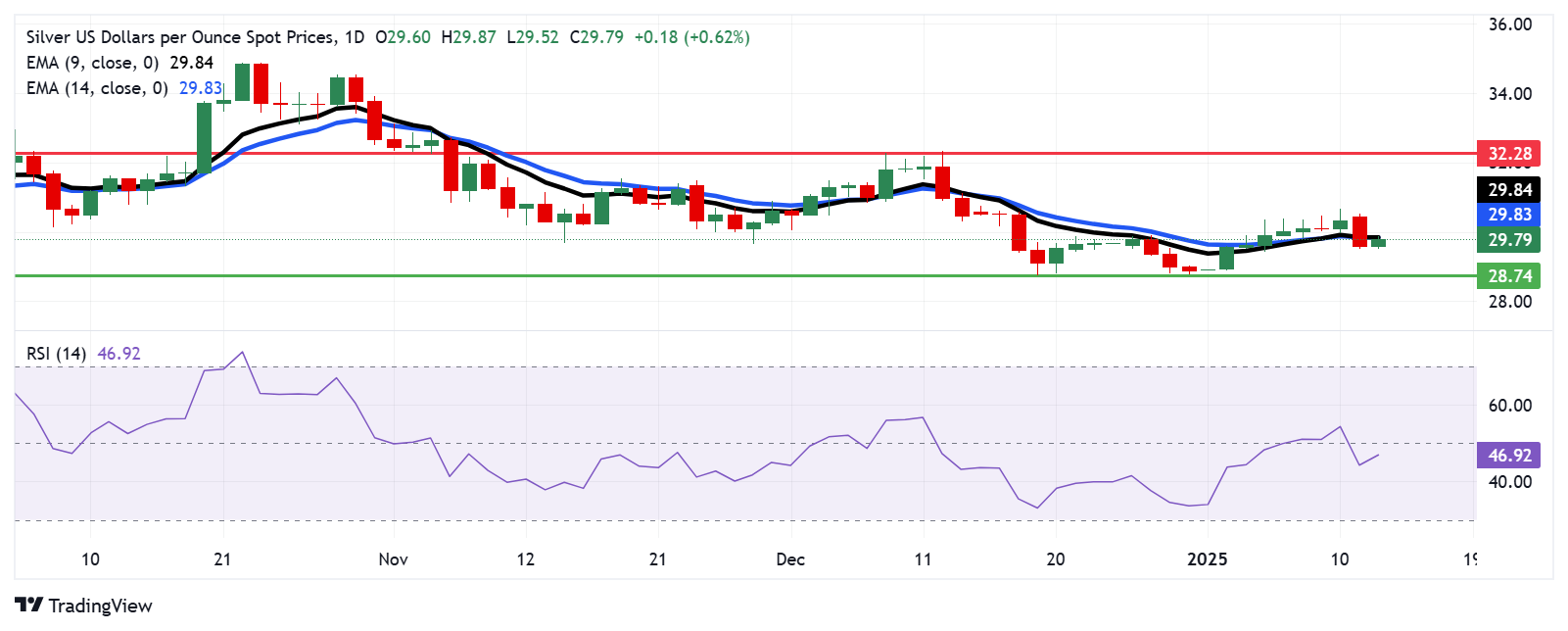Silver Price Forecast: XAG/USD tests 14-day EMA near $30.00
- Silver price tests immediate resistance at the 14-day EMA of $29.83 level.
- The 14-day RSI consolidates around the 50 level, indicating a neutral market outlook.
- The pair may test initial support at the four-month low of $28.74, recorded on December 19.
Silver price (XAG/USD) recovers some of their recent losses from the previous session, trading near $29.80 per troy ounce during European trading hours on Tuesday. Analyzing the daily chart suggests that short-term price momentum appears neutral, with the XAG/USD pair positioned around the nine-day and 14-day Exponential Moving Averages (EMAs). A breakout in either direction could signal a clearer trend.
Moreover, the 14-day Relative Strength Index (RSI) hovers near the 50 level, suggesting a neutral outlook. This suggests the market is evenly balanced, with no clear indication of overbought or oversold conditions, reflecting equilibrium between bullish and bearish momentum.
Silver price currently tests resistance at the immediate 14-day EMA of $29.83, followed closely by the nine-day EMA at $29.84. A breakout above these levels could boost market sentiment and drive the XAG/USD pair toward the key psychological level of $30.00. A sustained move beyond this threshold may strengthen bullish momentum, potentially setting the stage for the grey metal to target its two-month high of $32.28, last achieved on December 9.
On the downside, initial support is located at the four-month low of $28.74, recorded on December 19, followed by the critical psychological level of $28.00. A break below these levels could intensify bearish momentum and signal further downside potential for Silver price.
XAG/USD: Daily Chart
Silver FAQs
Silver is a precious metal highly traded among investors. It has been historically used as a store of value and a medium of exchange. Although less popular than Gold, traders may turn to Silver to diversify their investment portfolio, for its intrinsic value or as a potential hedge during high-inflation periods. Investors can buy physical Silver, in coins or in bars, or trade it through vehicles such as Exchange Traded Funds, which track its price on international markets.
Silver prices can move due to a wide range of factors. Geopolitical instability or fears of a deep recession can make Silver price escalate due to its safe-haven status, although to a lesser extent than Gold's. As a yieldless asset, Silver tends to rise with lower interest rates. Its moves also depend on how the US Dollar (USD) behaves as the asset is priced in dollars (XAG/USD). A strong Dollar tends to keep the price of Silver at bay, whereas a weaker Dollar is likely to propel prices up. Other factors such as investment demand, mining supply – Silver is much more abundant than Gold – and recycling rates can also affect prices.
Silver is widely used in industry, particularly in sectors such as electronics or solar energy, as it has one of the highest electric conductivity of all metals – more than Copper and Gold. A surge in demand can increase prices, while a decline tends to lower them. Dynamics in the US, Chinese and Indian economies can also contribute to price swings: for the US and particularly China, their big industrial sectors use Silver in various processes; in India, consumers’ demand for the precious metal for jewellery also plays a key role in setting prices.
Silver prices tend to follow Gold's moves. When Gold prices rise, Silver typically follows suit, as their status as safe-haven assets is similar. The Gold/Silver ratio, which shows the number of ounces of Silver needed to equal the value of one ounce of Gold, may help to determine the relative valuation between both metals. Some investors may consider a high ratio as an indicator that Silver is undervalued, or Gold is overvalued. On the contrary, a low ratio might suggest that Gold is undervalued relative to Silver.
